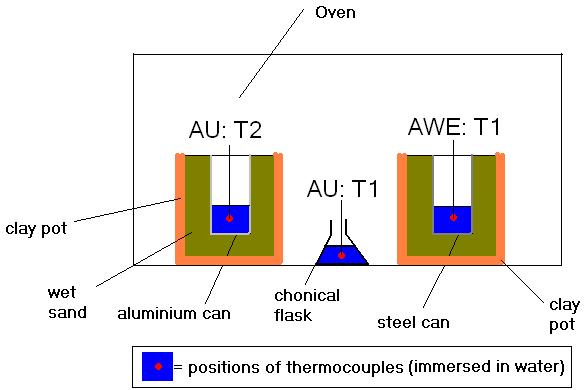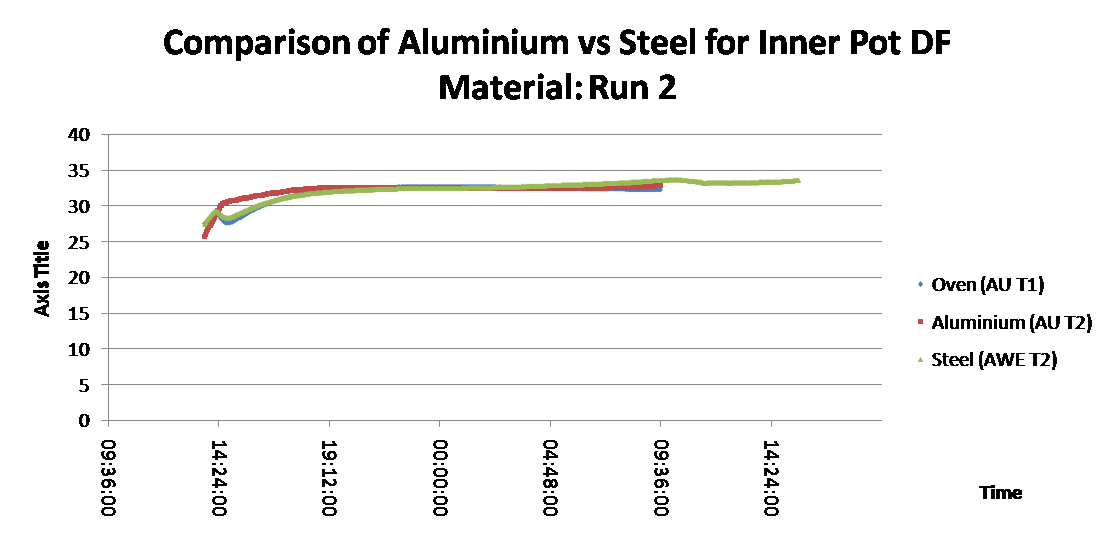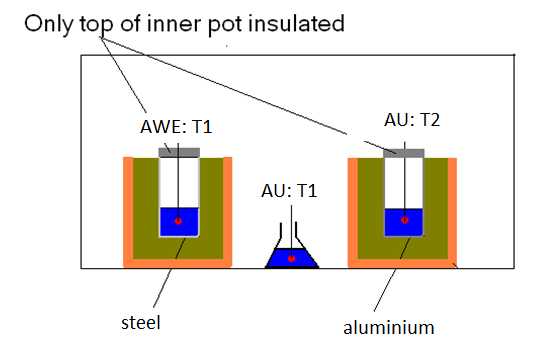Inner pot DF: Steel vs Aluminium (more new results)
The results of the first run of the experiment to compare the effectiveness of Steel vs Aluminium as the material for the inner pot material were very strange so I decided to re-run it and a summary of the results is given below (complete data here and notes) :
Run 1: 16/7/10 See previous post
See previous post

Run 2: 22/7/10  To reduce heat transfer from oven straight through to inner pot, the top surface of both the Desert Fridges were completely insulated with a sheet of polystyrene.
To reduce heat transfer from oven straight through to inner pot, the top surface of both the Desert Fridges were completely insulated with a sheet of polystyrene.
Furthermore, efforts were made to ensure the thermocouples remained in the exact positions they were supposed to be kept in using blu- tack and selotape to hold them in place.
Initially there was some small deviation of the aluminium above the oven temperature (reason unknown) while the system warmed up. Once equilibrated, both the steel and aluminium showed virtually zero difference to the surrounding oven temperature. This may have been because the insulating layer added would have prevented evaporation of water from the exposed sand layer at the top surface which would reduce the cooling effect.
Run 3: 26/7/10  This time, to allow evaporation of water from the exposed sand while reducing heat from the surroundings to the inner pot; the insulting layer of polystyrenes was cut such that it only covered the top of the inner pot while leaving the sand section exposed.
This time, to allow evaporation of water from the exposed sand while reducing heat from the surroundings to the inner pot; the insulting layer of polystyrenes was cut such that it only covered the top of the inner pot while leaving the sand section exposed.
This gave the best results, i.e the largest sustained temperature difference (approx 5oc) between the inner pot (both and surrounding oven temperature. The steel pot was negligibly (less than 0.1oC) cooler than aluminium, but this is so small it could have been due to the slight variation in temperature due to its position within the oven or the slight variations in the outer pot (clay) and/or sand layer material properties, rather than due to inner pot material itself.
However the performance of both DFs was still much worse than that recorded in previous similar experiments where a sustained temperature difference of 10oC was maintained.
Conclusions
This series of experiments suggests that there is no significant difference in performance of the Desert Fridge between using aluminium or steel as the inner pit material.
Furthermore, we can conclude that the only significant heat transfer process is though the top surface of the Desert Fridge. If this is true it would completely contradict the 1-D theoretical model of the DF we have been developing which assumes the heat transfer in this direction is insignificant compared to that through the walls of the outer pot.
Porosity of outer clay pot
However these results may be because in this specific experiment the outer pots were not significantly porous, as if this were the case then there would be insignificant diffusion of water and resultant heat transfer process in this direction.
The porosity of the terracotta outer pots were tested for by spraying the surface with water and a positive results was observed as the water was quickly absorbed. Furthermore, when the pots were submerged in water to be saturated for the experiments air bubble evolving from the surface of the pots were observed which also suggested they were porous.
However on further consideration, these tests only proved the pots were porous but even if there were few/ no interconnected pathways of theses pores from the inner to the outer surface, then the hydraulic conductivity and the resultant heat transfer process could still have been insignificant.
Here is a method of accurately determining the hydraulic conductivity of terracotta pots. However this is very time consuming. In any case is very difficult to accurately reproduce terracotta pots with the same porosity as the it is affeceted by so many variables including: clay type, firing temperature, molding method, additives and water content etc . Even if we are able to reproduce samples in lab conditions will this really be practical for implementation? Therefore should we consider discontinuing investigations using terracotta pots and concentrate on other more reliable materials?...
Inner pot DF: Steel vs Aluminium (more new results)
The results of the first run of the experiment to compare the effectiveness of Steel vs Aluminium as the material for the inner pot material were very strange so I decided to re-run it and a summary of the results is given below (complete data here and notes) :
Run 1: 16/7/10 See previous post
See previous post
Run 2: 22/7/10  To reduce heat transfer from oven straight through to inner pot, the top surface of both the Desert Fridges were completely insulated with a sheet of polystyrene.
To reduce heat transfer from oven straight through to inner pot, the top surface of both the Desert Fridges were completely insulated with a sheet of polystyrene.
Furthermore, efforts were made to ensure the thermocouples remained in the exact positions they were supposed to be kept in using blu- tack and selotape to hold them in place.Initially there was some small deviation of the aluminium above the oven temperature (reason unknown) while the system warmed up. Once equilibrated, both the steel and aluminium showed virtually zero difference to the surrounding oven temperature. This may have been because the insulating layer added would have prevented evaporation of water from the exposed sand layer at the top surface which would reduce the cooling effect.
Run 3: 26/7/10  This time, to allow evaporation of water from the exposed sand while reducing heat from the surroundings to the inner pot; the insulting layer of polystyrenes was cut such that it only covered the top of the inner pot while leaving the sand section exposed.
This time, to allow evaporation of water from the exposed sand while reducing heat from the surroundings to the inner pot; the insulting layer of polystyrenes was cut such that it only covered the top of the inner pot while leaving the sand section exposed.
This gave the best results, i.e the largest sustained temperature difference (approx 5oc) between the inner pot (both and surrounding oven temperature. The steel pot was negligibly (less than 0.1oC) cooler than aluminium, but this is so small it could have been due to the slight variation in temperature due to its position within the oven or the slight variations in the outer pot (clay) and/or sand layer material properties, rather than due to inner pot material itself.However the performance of both DFs was still much worse than that recorded in previous similar experiments where a sustained temperature difference of 10oC was maintained.
Conclusions
This series of experiments suggests that there is no significant difference in performance of the Desert Fridge between using aluminium or steel as the inner pit material.Furthermore, we can conclude that the only significant heat transfer process is though the top surface of the Desert Fridge. If this is true it would completely contradict the 1-D theoretical model of the DF we have been developing which assumes the heat transfer in this direction is insignificant compared to that through the walls of the outer pot.
Porosity of outer clay pot
However these results may be because in this specific experiment the outer pots were not significantly porous, as if this were the case then there would be insignificant diffusion of water and resultant heat transfer process in this direction.The porosity of the terracotta outer pots were tested for by spraying the surface with water and a positive results was observed as the water was quickly absorbed. Furthermore, when the pots were submerged in water to be saturated for the experiments air bubble evolving from the surface of the pots were observed which also suggested they were porous.
However on further consideration, these tests only proved the pots were porous but even if there were few/ no interconnected pathways of theses pores from the inner to the outer surface, then the hydraulic conductivity and the resultant heat transfer process could still have been insignificant.
Here is a method of accurately determining the hydraulic conductivity of terracotta pots. However this is very time consuming. In any case is very difficult to accurately reproduce terracotta pots with the same porosity as the it is affeceted by so many variables including: clay type, firing temperature, molding method, additives and water content etc . Even if we are able to reproduce samples in lab conditions will this really be practical for implementation? Therefore should we consider discontinuing investigations using terracotta pots and concentrate on other more reliable materials?...
No comments:
Post a Comment